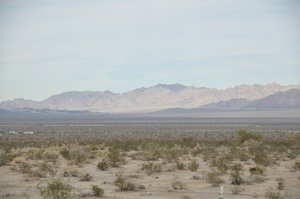Advertisement
Published: March 8th 2010

 Photo 01
Photo 01
Joshua Tree National Park without Joshua Trees. This part of the park is in the Sonoran Desert which has none of the vegetation of the north section which is in the Mojave Desert.Our next phase of the trip was to meet up with our son, Nick, in Joshua Tree National Park in southern California. This was a park that neither of us had explored but Nick knows quite well and we were really looking forward to being introduced.
We met Nick in the Cottonwood campground, on the south side of the park. Before he arrived, we were looking all over for Joshua Trees, not knowing that we were in the Sonoran Desert and Joshua Trees don’t grow there. This large park is comprised of the Sonoran in the south and the Mojave Desert in the north and the vegetation and geology are quite different. As shown in the Photo 1, the landscape was rolling and dotted with creosote bushes with mountains in the background. We visited an oasis near the campground (Photo 2) with many palm trees and much green.
At Nick’s urging, the next day we drove farther north and much higher into the park. The vegetation and terrain changed dramatically. We parked in a canyon in the Jumbo Rocks campsite (Photo 3). The Joshua Tree in the Mohave Desert part of the park was very plentiful. This

 Photo 02
Photo 02
The desert oasis at Cottonwood was filled with green foliage and palm trees.“tree” is really a yucca, a member of the lily family. It is maybe 25-40 ft maximum, sometimes with multiple branches (Photo 4). There are also lots of junipers there (Photo 5). Note the berries on the juniper. The male plants produce much pollen that had our noses twitching.
On the second day, we climbed Mt. Ryan. One of the treats of the climb was watching a group of tightrope walkers try to cross between two peaks (Photos 6 and 7). They were hundreds of feet above the ground but had safety lines attached to the tightrope. It was a bit windy and we never saw anyone make it across, but we did hear lots of frustrated cursing! As far as we know, no one was hurt.
The climb up Mt. Ryan was breathtaking and the view memorable (Photos 8 and 9). Many people were doing rock climbing, some quite technical. Nick and others, climbed to the top of the huge boulders (Photo 10). Pairs of ravens getting ready for the breeding season were common in the park (Photo 11).
The park has a cholla garden, an area where lovely and nasty cactus grows.

 Photo 03
Photo 03
Our campsite at Jumbo Rocks in the Mojave Desert.There were several varieties, the pencil cholla (Photo 12) and the jumping cholla (Photo 13). There is also a section of the park that features the ocotilla plant (Photo 14 and 15) that looks like a set of dead limbs reaching to the sky until some rain falls. Then these lovely reddish blooms appear like flags on a flagpole.
The rock formations reminded us of nature’s art. Photo 16 is called skull rock. Photo 17 appeared to be a huge octopus on the desert floor. The formation in Photo 18 reminded us that the rocks were both sedimentary and volcanic in formation. Other formations truly indicated the beauty of the natural world (Photo 19). There were beautiful desert birds (Photos 21-24) including the phainopepla, white-crowned sparrow, scrub jay and the ever-present cactus wren.
We next spent a few days in the Palm Springs area, partly to do laundry and to re-provision and also to see more of the south California desert. One of the more striking aspects was the huge series of wind farms that occupy the valley (photo 25). The surrounding mountains were totally breathtaking (Photo 26}.
The Salton Sea was our next

 Photo 04
Photo 04
A very large Joshua Tree; many have only two or three branches.destination with Nick. Approaching this lake we were struck with its beauty and with the dearth of people (Photo 27). Actually, this body of water was created by people, accidently. During the early 1900s, after the construction of irrigation canals along the Colorado River, there was a large flood and the whole river changed direction and flooded the basin where the lake is now. Eventually, the river was redirected to its original course. The Sea became a favorite destination for Californians. However, over the years, the water has become more and more salty since it receives little freshwater input. The salinity is now about 25% higher than seawater. There are several species of fish, including tilapia, that exist there now but they will probably be extirpated as the salinity rises. The many birds, such as the white pelican, that depend on the fish will have to leave, which is sad (Photo 28).
We made a day trip to Slab City, a hippy style collection of colorful RVs, and painted rocks just sitting on the unused private or public land (photos 29-30}. Other interesting things in the area including a date farm and a geothermal generating station. After saying

 Photo 05
Photo 05
Juniper berries waiting to be made into gin!goodbye to Nick, we headed east into Arizonia to meet up with our good friends Peter and Trudy Brussard for a trip to south Texas and a biosphere preserve in Mexico. More on that is the next travelblog!
Advertisement
Tot: 0.049s; Tpl: 0.012s; cc: 11; qc: 18; dbt: 0.0255s; 1; m:domysql w:travelblog (10.17.0.13); sld: 1;
; mem: 1.1mb























